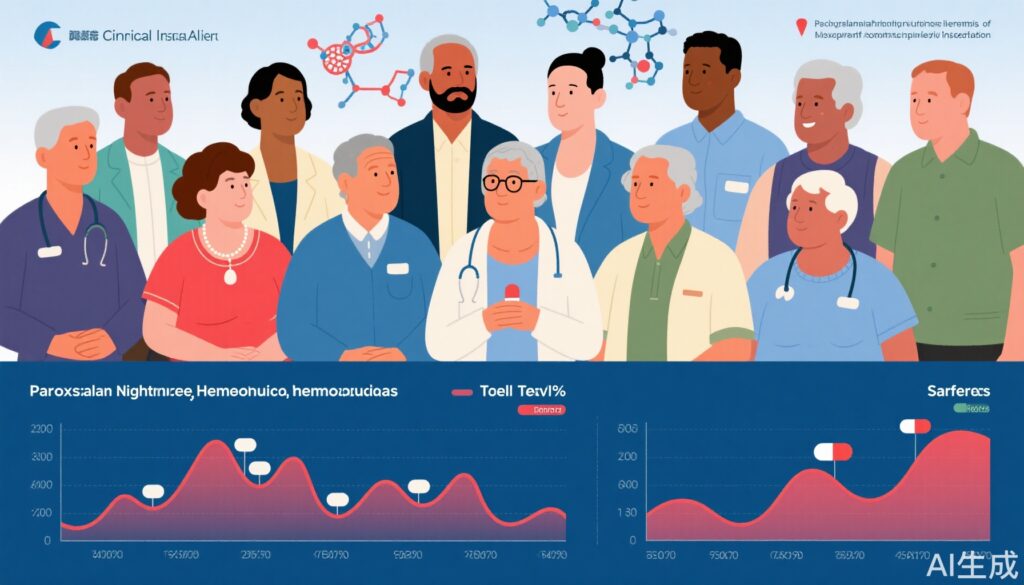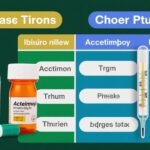Highlights
- Iptacopan, an oral factor B inhibitor, demonstrated durable control of haemolysis and improved haemoglobin levels over 48 weeks in both anti-C5-experienced and complement-inhibitor-naive PNH patients.
- High proportions of patients achieved clinically meaningful haemoglobin increases (≥2 g/dL) and normalization (≥12 g/dL) without new safety concerns.
- Breakthrough haemolysis and severe adverse events were infrequent, with no treatment discontinuations due to adverse events or deaths.
Study Background and Disease Burden
Paroxysmal nocturnal haemoglobinuria (PNH) is a rare, life-threatening hematologic disorder characterized by chronic complement-mediated intravascular haemolysis, leading to anaemia, thrombosis, and significant morbidity. While anti-C5 monoclonal antibodies (eculizumab, ravulizumab) have transformed PNH management by reducing haemolysis and thrombotic events, many patients continue to experience anaemia due to persistent extravascular haemolysis, require ongoing transfusions, and face the burden of intravenous therapy. The need for more effective, convenient, and comprehensive therapies remains unmet. Iptacopan, an oral inhibitor of complement factor B, targets the alternative pathway upstream of C5, potentially offering superior haemolysis control and greater patient convenience.
Study Design
The phase 3 APPLY-PNH and APPOINT-PNH trials evaluated the efficacy and safety of iptacopan in distinct PNH populations:
- APPLY-PNH: An open-label, randomized study conducted across 39 centers in 12 countries, enrolling adults (≥18 years) with PNH (≥10% red and white cell clone size) and no laboratory evidence of bone marrow failure, who had haemoglobin <10 g/dL despite ≥6 months of stable anti-C5 therapy (eculizumab or ravulizumab). Patients were randomized (8:5) to receive oral iptacopan 200 mg twice daily or continue intravenous anti-C5 therapy for 24 weeks. All participants then entered a 24-week extension on open-label iptacopan.
- APPOINT-PNH: An open-label, single-arm trial at 12 hospitals in 8 countries, enrolling complement inhibitor-naive adults with PNH, haemoglobin 1.5× upper normal limit. All received iptacopan 200 mg twice daily for 24 weeks, followed by a 24-week extension.
Primary endpoints (previously reported) were the proportion of patients achieving ≥2 g/dL haemoglobin increase and, for APPLY-PNH, haemoglobin ≥12 g/dL at weeks 18–24, without transfusions from weeks 2–24. The final 48-week analysis included the proportion of patients with haemoglobin increase ≥2 g/dL or haemoglobin ≥12 g/dL (with or without transfusions), safety, and durability of response.
Key Findings
Patient Demographics and Exposure
- APPLY-PNH: 62 patients were randomized to iptacopan (69% female, 77% White, 19% Asian, 3% Black) and 35 to anti-C5 (69% female, 74% White, 20% Asian, 6% Black); nearly all entered the extension period. Median iptacopan exposure was 337 days.
- APPOINT-PNH: 40 patients (43% female, 68% Asian, 30% White) received iptacopan for a median of 337 days.
Efficacy Outcomes at Week 48
- In the APPLY-PNH iptacopan group, 86% achieved a haemoglobin increase ≥2 g/dL, and 68% achieved haemoglobin ≥12 g/dL at 48 weeks.
- Among those who switched from anti-C5 to iptacopan during the extension, 72% achieved ≥2 g/dL increase and 59% reached ≥12 g/dL haemoglobin.
- In APPOINT-PNH (complement-inhibitor naive), 97% achieved ≥2 g/dL increase and 79% reached ≥12 g/dL haemoglobin.
These results indicate that iptacopan provides rapid and sustained improvements in haemoglobin, both as first-line therapy and after anti-C5 treatment failure or suboptimal response.
Haemolysis Control and Transfusion Independence
Iptacopan led to durable control of haemolysis, with a low incidence of clinical breakthrough haemolysis: 7% in APPLY-PNH and 5% in APPOINT-PNH, generally mild/moderate and not leading to discontinuation.
Safety Profile
- No deaths or treatment discontinuations due to adverse events were reported.
- The most common adverse event was COVID-19 in APPLY-PNH (29% iptacopan; 24% anti-C5-to-iptacopan) and headache in APPOINT-PNH (30%).
- Severe and serious adverse events were infrequent, with no clustering or new safety signals. Major vascular events (n=3) were adjudicated as unrelated to iptacopan.
Expert Commentary
These findings confirm and extend the 24-week results, demonstrating that iptacopan—an oral, upstream complement inhibitor—provides not only non-inferior but potentially superior haemolysis control and haemoglobin normalization compared to standard anti-C5 therapy. Importantly, the oral formulation offers a significant advantage in terms of patient convenience and quality of life. The low incidence and mild severity of breakthrough haemolysis, coupled with the absence of new safety concerns over nearly a year of exposure, are particularly reassuring.
However, some limitations should be acknowledged: the open-label design could introduce bias, and long-term data beyond 48 weeks are needed to fully establish risks of late complications, such as infection or thrombosis. The studies’ exclusion of patients with bone marrow failure limits generalizability to all PNH populations. Furthermore, while the study was broad in geographic reach, real-world data will be essential to confirm benefit across diverse healthcare settings.
Current guidelines for PNH management emphasize individualized therapy focused on sustained haemolysis control, minimization of transfusion needs, and patient preference. Iptacopan, based on this robust evidence, is poised to become a preferred option for both anti-C5-experienced and treatment-naive patients, potentially defining a new standard of care.
Conclusion
The 48-week results from the APPLY-PNH and APPOINT-PNH phase 3 trials provide compelling evidence that oral iptacopan monotherapy achieves durable haemolysis control, haemoglobin normalization, and a favorable safety profile in PNH patients regardless of prior anti-C5 therapy. These data support its adoption as a transformative, convenient, and effective therapy for PNH and herald a new era in disease management. Ongoing and future studies should further clarify long-term safety, efficacy in broader populations, and real-world effectiveness.
References
Risitano AM, Kulasekararaj AG, Scheinberg P, Röth A, Han B, Maciejewski JP, Ueda Y, de Castro CM, Di Bona E, Fu R, Zhang L, Griffin M, Langemeijer SMC, Panse J, Schrezenmeier H, Barcellini W, Mauad VAQ, Schafhausen P, Tavitian S, Beggiato E, Chew LP, Gaya A, Huang WH, Jang JH, Kitawaki T, Kutlar A, Notaro R, Pullarkat V, Schubert J, Terriou L, Uchiyama M, Lee LWL, Yap ES, Frieri C, Marano L, de Fontbrune FS, Gandhi S, Trikha R, Alashkar F, Yang C, Liu H, Kelly RJ, Höchsmann B, Lawniczek T, Mahajan N, Solar-Yohay S, Kerloëguen C, Ferber P, Kumar R, Wang Z, Thorburn C, Maitra S, Li S, Verles A, Dahlke M, de Latour RP. Oral iptacopan monotherapy in paroxysmal nocturnal haemoglobinuria: final 48-week results from the open-label, randomised, phase 3 APPLY-PNH trial in anti-C5-treated patients and the open-label, single-arm, phase 3 APPOINT-PNH trial in patients previously untreated with complement inhibitors. Lancet Haematol. 2025 Jun;12(6):e414-e430. doi: 10.1016/S2352-3026(25)00081-X. PMID: 40447351.



